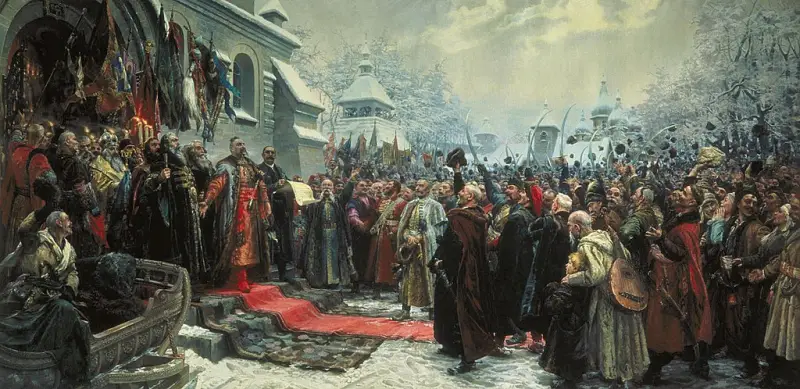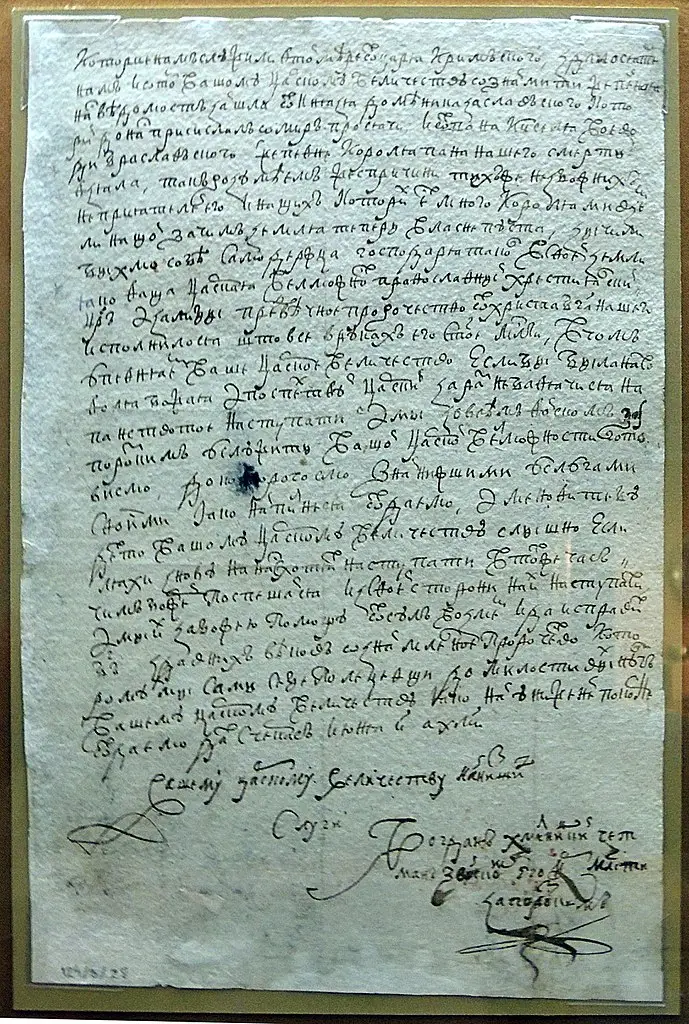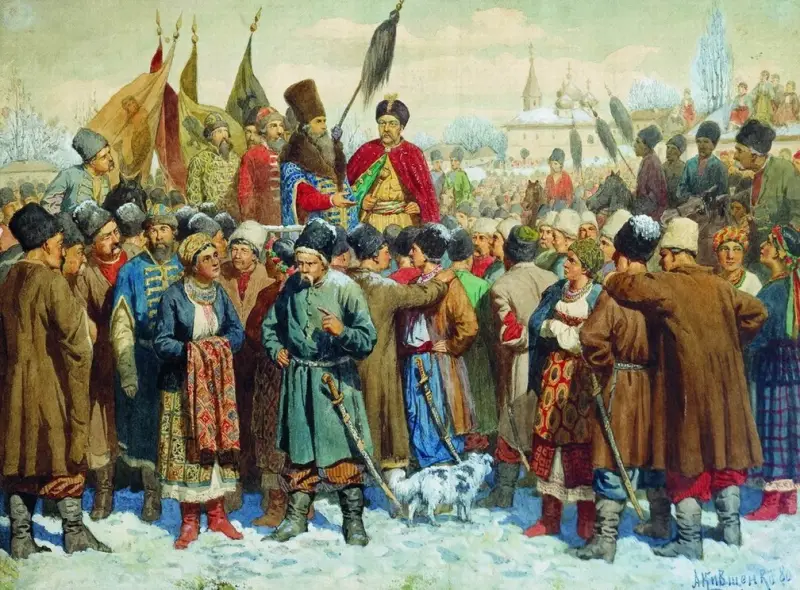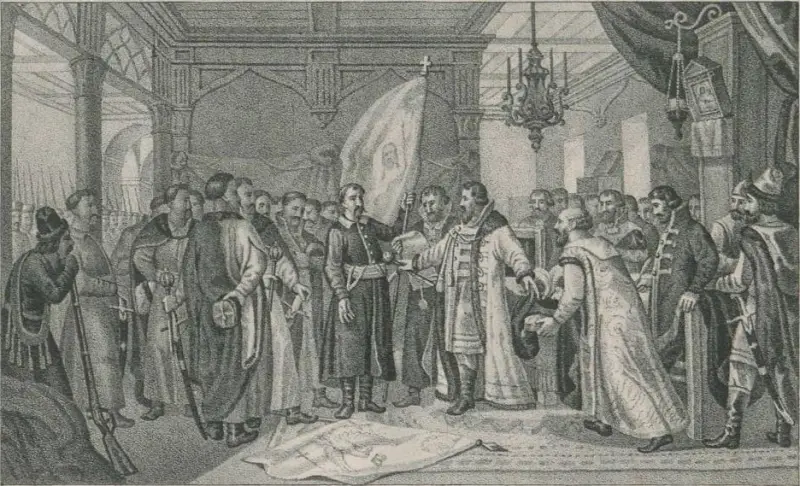Reunification of Rus': “so that everyone may be one forever”

“Forever with Moscow, forever with the Russian people” (1951). Painting by Mikhail Ivanovich Khmelko
370 years of the Pereyaslav Rada. Reunification of Little Rus' with Great Russia. The people of the illegally seized Russian Ukraine swear allegiance to Tsar Alexei Mikhailovich and decide on reunification.
Ancient, epic Rus' has reunited. Since 1991, the Russian land and the Russian people were again illegally divided. The time will come and there will be a new Pereyaslav Rada! Rus' will be united!
Grand Embassy
Exhausted by the difficult and bloody struggle with the Polish-Lithuanian Commonwealth, crop failures and epidemics, Little Rus' (Hetmanate, Russian Ukraine, Zaporozhian Army) requested help from fraternal Russia. Hetman Bohdan Khmelnytsky repeatedly asked to accept the Zaporozhye Army under the arm of the Russian Tsar. Moscow, fearing the power of Poland and because of internal problems, was in no hurry and waited. However, after several years of fierce struggle, it became obvious that the opportune moment had arrived to enter the struggle for the western part of Rus'.
The request of the Zaporozhian Army for Russian citizenship was considered at the Zemsky Sobor (How the historic decision was made to reunite the Russian land), held in Moscow on October 1 (11), 1653. As a result, the Zemsky Sobor decided:
The age-old dream of the Little Russian part of the Russian people of reunification with Russia has come true. Khmel's uprising against the Polish lords ultimately led to the Russian War of Liberation and forced Moscow to abandon its cautious policy and enter into a fight with the Polish-Lithuanian Commonwealth for the unity of the Russian land.
On October 9, 1653, the great and plenipotentiary ambassadors Vasily Buturlin, Ivan Alferyev and Larion Lopukhin left Moscow. They were accompanied by a large retinue, including the head of the Moscow archers Artamon Matveev with archers. Bohdan Khmelnytsky’s envoy Lavrin Kapusta also left with them.
On October 15, the embassy was in Kaluga, on October 27 - in Sevsk, on November 1 - in Putivl. On December 3, Colonel Kalnitsky Ivan Fedorenko arrived in Putivl. He gave boyar Buturlin a letter from the hetman, in which he expressed joy at the decision of the Zemsky Sobor and the arrival of the ambassadors. Khmel asked the ambassadors to wait for him in Pereyaslav until he returned to Chigirin. They decided not to go to Chigirin (the hetman’s headquarters), since “the city is small and the locusts ate the grass, and where the locusts did not eat, and here due to the drought, no bread was born, and bread and food are scarce in those places.”
Pereyaslav was then the second large economic and administrative center of Little Russia after Kyiv, the old Cossack regimental center on the Left Bank of the Dnieper. Ivan Fedorenko was supposed to escort the sovereign's ambassadors to this city.
Khmel at that time was near Kamenets-Podolsky and kept the army of the Polish king, who dug in near Zhvanets, under siege. The Polish army was cut off from its bases, lived from hand to mouth, and suffered heavy losses from Cossack attacks. The Polish army was in danger of disaster.
But the Crimean Khan, as at Zborov, betrayed the hetman. Having learned about Moscow's decision, Islam-Girey hastened to come to an agreement with Jan-Kazimir (How Islam-Girey prevented Khmelnitsky from destroying the Polish army near Zhvanets). On December 5, 1653, the Zhvanetsky Treaty was concluded. The king paid the Crimeans a large indemnity and allowed the Tatars to take yasyr in Volyn from the Cossacks and Rusyns (as the Russians were called in Little Russia).
In an effort to keep Khmel from concluding an alliance with the Russian kingdom, Islam invited him to make peace with Poland on the terms of the Treaty of Zborov. The king was forced to make concessions. For this, the Cossacks had to take part in the war with Russia.
Khmelnitsky refused. Having gathered a council of colonels, he discussed the current situation with them. It was decided to return home. Hops near Mezhigor defeated a large Crimean Tatar detachment, which was returning with great booty and full, after the devastation of Lithuanian Rus.

Letter from Hetman Bogdan Khmelnytsky to Tsar Alexei Mikhailovich with a message about victories over Polish troops and the desire of the Zaporozhye Cossacks to enter into Russian citizenship. Cherkassy, 1648, June 8. RGADA
Pereislav
On December 24, 1653, Khmelnitsky returned to Chigirin. He writes a letter to the Russian ambassadors asking them to hurry to Pereyaslav for negotiations. On December 26, the hetman sent a messenger along with the grassroots Zaporozhye Army with a letter of gratitude to the Sich and a request for an immediate response on the matter of reunification.
On the same day, Bogdan received Russian ambassadors Rodion Streshnev and Martemyan Bredikhin, who arrived back in October. The negotiations were conducted by Khmelnitsky and the military clerk Ivan Vygovsky. Issues related to reunification and war with Poland were discussed.
The Moscow embassy solemnly arrives in Pereyaslav. He is met by Pereyaslavl military colonel Pavel Teterya “with banners, and with trumpets, and with kettledrums.” The ambassadors are met by townspeople, Cossacks and clergy “with crosses, and icons, and banners, and holy water.” In his welcoming speech, Pereyaslavl archpriest Gregory expressed satisfaction on behalf of everyone about the reunification of “united Little and Great Russia.” A prayer service was held in the Assumption Cathedral Church.
Hetman Khmelnitsky arrived in Pereyaslav on January 6, 1654. With him came Cossack elders and colonels, representatives of the Kyiv townspeople (citizens), 5–10 Cossacks from each regiment. The Hetman held a meeting with the sovereign's ambassadors, discussing the terms of reunification.
On the morning of January 8 (18), 1654, the Rada of Elders was held. She approved of the reunion. It was also decided to convene a combined arms, people's Rada. On the same day, a messenger arrived from the Zaporozhye Sich. The Cossacks approved the transfer of the Little Russian people living on both sides of the Dnieper to the hand of the Russian sovereign.

Pereyaslavskaya Rada. 1654 Painting by Alexey Kivshenko. 1880
Historical decision
In the afternoon, the national Rada gathered on Pereyaslavskaya Square. Hetman Bohdan Khmelnitsky spoke to the people:
For this reason, we have now assembled a Rada, which is visible to all the people, so that we can naturally choose the Sovereign from among the four whom you want; the first King is the Turk, who many times through his ambassadors called us under his region; second Khan of Crimea; the third King of Poland, who, if he wishes, can still accept us with his former affection; the fourth is the Orthodox Great Russia Sovereign, Tsar and Grand Duke Alexei Mikhailovich, the Eastern Autocrat of All Russia, whom we have been asking ourselves for six years with our incessant prayers; elect whomever you want.
The King of Tours is a busurman; You all know how our brethren, Orthodox Christians, the Greeks suffer misfortune, and what kind of oppression they are from the godless; The Khan of Crimea is also a busurman, whom we accepted out of need and friendship, what unbearable troubles we accepted! What captivity, what merciless shedding of Christian blood from the Polish Lords of oppression, no one needs to tell you; You yourselves all know that you respected a Jew and a dog better than a Christian, our brother. And the Orthodox Christian Great Sovereign, the King of the East, is with us of one piety of the Greek law, one confession, one body of the church with the Orthodoxy of Great Russia, the head of which is Jesus Christ.
That Great Sovereign, the Tsar of Christianity, taking pity on the unbearable bitterness of the Orthodox Church in our small Russia, not despising our six-year-old prayers of unceasing, now has merciful his Tsar’s heart and inclined us, deigned to send his great neighbors to us with the Tsar’s mercy, whom he has we will love with zeal, except for His Tsarist high hand of the most merciful shelter which is not obscure; and there will be someone who does not agree with us now, wherever he wants, a free road. To these words, all the people cried out: we are free under the Tsar of the East, the Orthodox, with a strong hand in our pious faith, die, rather than not the hater of Christ, trash, wealth.
Then Colonel Preyaslovsky Teteria, walking in a circle on all sides, asked: do you all so deign to be the whole nation: all are unanimous;
then the Hetman prayed: be so, that the Lord our God will strengthen us under His royal strong hand; A the people all unanimously cried out over him: God! confirm, God! strengthen us so that we may all be one forever.”
Thus the reunification of Little and Great Russia was proclaimed. The great goal to which parts of the united people were striving was accomplished.
Immediately after the Rada, Khmelnitsky and the military foreman arrived at the retreat yard of the boyar Buturlin. The voivode handed them the royal letter, confirming the consent of the Russian government to the reunification of the Russian lands and made a speech about stories relationship between the Zaporozhian Army and the Russian state.
Then everyone went to the Assumption Cathedral Church to take the oath. Representatives of the Russian clergy arrived to swear in the Little Russian people - Archimandrite Prokhor of the Kazan Transfiguration Monastery and Archpriest Adrian with priests and deacons. The first to swear allegiance were the hetman, the military clerk, the convoy and military judges, captains and colonels. The names of all of them were entered into a special “official” book, “which was sent from the sovereign.”
After the oath was taken to Bohdan Khmelnitsky, in the presence of elders, Cossacks and townspeople, a new banner of the Zaporozhian Army, a mace, as a sign of hetman’s dignity, a “ferez” and a hat were handed over. The foreman was given royal gifts. The next day, the members of the People's Rada and residents of the city were sworn in.
Khmelnitsky stayed in the city for several more days, met with ambassadors, discussing important matters. He handed over the letter to Tsar Alexei Mikhailovich and on January 13 (23) he left for Chigirin. The next day the sovereign ambassadors also departed.
Soon after the Pereyaslav Rada, the official title of the Russian Tsar was changed: in it the words “All Russia” were replaced with “All Great and Little Russia (Russia)”, “Kievsky” was added to the title of the sovereign and “Chernigov” was returned.
Khmelnitsky is hastily preparing the Army for a new stage of the fight against the Polish-Lithuanian Commonwealth. At the same time, the hetman and the foreman are working out the conditions for reunification. They went down in history as the “March articles” or “Bohdan Khmelnitsky’s articles.”
In accordance with the agreement, the sovereign's troops began to arrive in Little Rus'. Thus, the boyar and governor of Rostov, Prince Fyodor Kurakin, and the boyar and governor of Galicia, Prince Fyodor Volkonsky, were sent to Kyiv as governors. The clerk of the Ambassadorial Prikaz, Andrei Nemirov, arrived with them. They were accompanied by a detachment of Colonel Yuri Golitsyn - 2 thousand soldiers, 500 archers, 100 boyar children and 5 gunners. Such detachments were also sent to other cities.
The sovereign's regiment entered Kyiv on February 23, 1654. He was solemnly greeted by the ordered Kiev colonel at the head of a thousand Cossacks with unfurled banners and townspeople. They hastily began to build a fortress.

Boyar Buturlin takes the oath of Russian citizenship from Hetman Khmelnytsky. B. A. Chorikov “Picturesque Karamzin, or Russian history in pictures”
Information